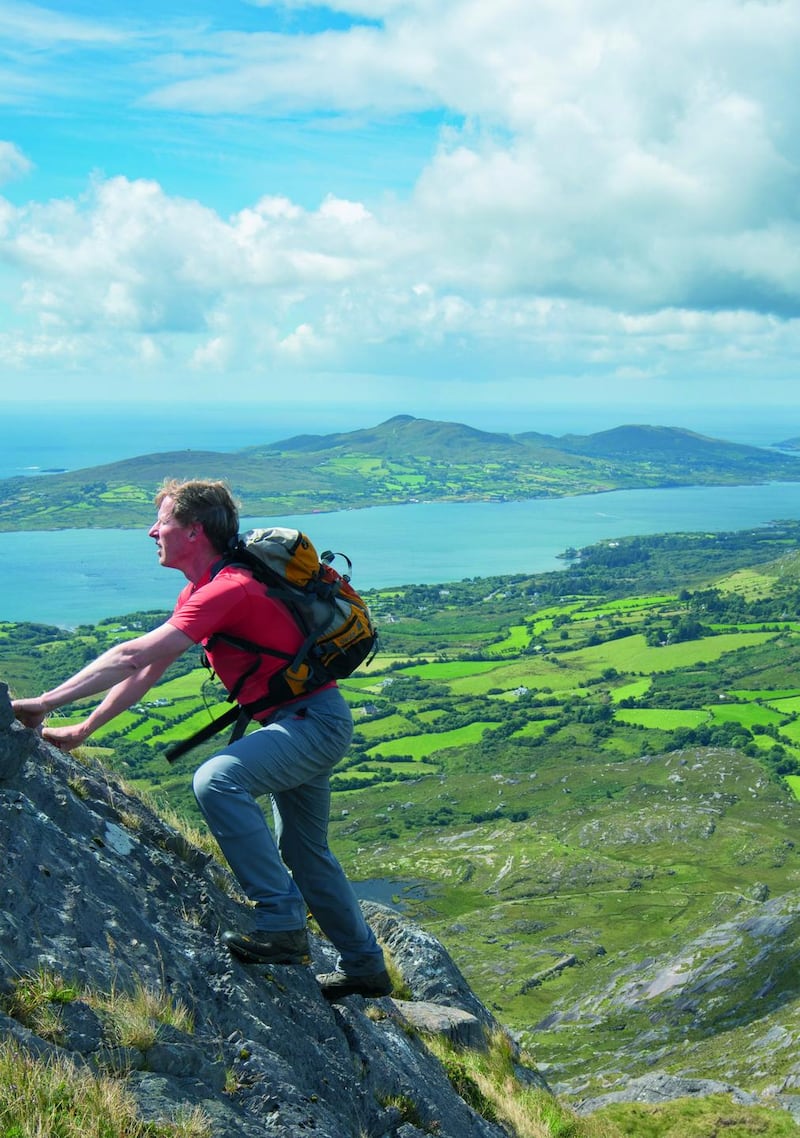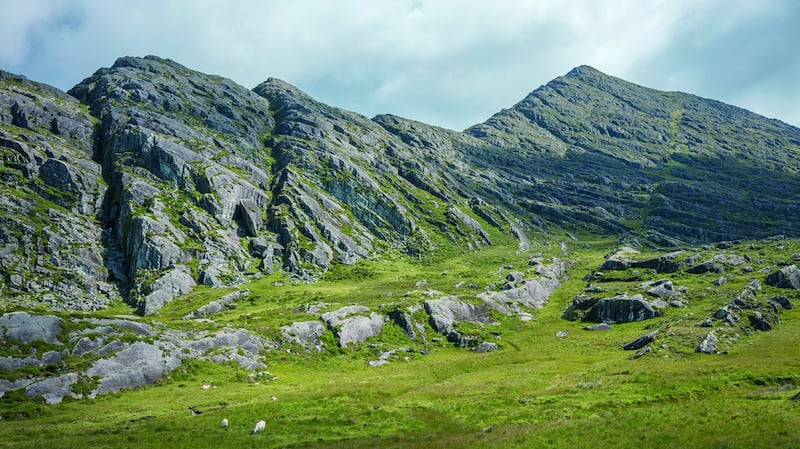HUNGRY HILL – Southwest Ridge
Great for
– Picking your line up grassy gullies and rocky steps
– Lifting your head from the engrossing terrain to enjoy fabulous coastal views
Conditions: A dry day with good visibility
Trip details: Grade of scramble: 1 – Easy
Distance: 11.5km (7 miles)
Access: The route starts and finishes at Park Lough, at the foot of the southwest ridge. Access the area via the R572 Glengarriff-Castletownbere road. Turn north on to a minor road near Rossmackowen Bridge, about 6km east of Castletownbere; use your OS map to locate the correct turning. There are a couple of informal parking spaces beside the lough itself – continue to the end of the minor road, pass through a gate on to a rough track, then park beside a track junction just before the lough. Alternatively, park along the verge at the bottom of the minor road, near the junction with the R572, then walk the extra kilometre to the lake.
Grid ref: V 748 484
GPS: 51.673774, -9.808889
Hungry Hill, the highest point on the Beara peninsula at 685m, is one of the most rugged mountains in Ireland. Its slopes are guarded by great blocks of sandstone that burst through the grass and thrust skyward. The endless crags present a formidable picture, and indeed the eastern side of the mountain is so steep – cut by a pair of dramatic, lake-filled corries – that progress here is reserved for rock climbers. For most scramblers, the 1.5km southwest ridge offers a far more manageable proposition. While it still looks imposing from below, the crags here are steep only in places, with easier-angled lines of weakness and grassy gullies never far away. You can choose your line of ascent to cross as many outcrops as you like, or to avoid them all together. The large number of variations means the scramble merits a rating of Grade 1: Easy, though there are plenty of options for short moderate or hard sections if you want to take them on.
From the summit, two alternative descent routes are described. The longer, more interesting option follows Hungry Hill’s northwest ridge, though a direct alternative is also available, saving you some 5.5km on the day’s total distance.

The scramble: From Park Lough, the southwest ridge lies directly ahead of you, its endless rock slabs quickening the heart with excitement or fear, depending on your perspective. A grassy ramp can be seen making a diagonal ascent up the southern slopes to a notch in the middle of the ridge, which some people use to access the second part of the shoulder. This would mean missing half the fun, however, so unless you're short of time, continue northwest along the track. The track forms part of the Beara Way, and will also be used at the end of the circuit. For now, follow it for 350m to the western tip of the ridge. The crags here descend right down to track level, and with the rocky crest stretching away behind, the ridge looks more difficult than it actually is. Turn right, pick your first line of weakness between the slabs, and begin making your way uphill.
There's no defined route to follow: it's simply a matter of weaving your way around and over the succession of small crags. Pick whichever route suits your party's abilities, staying generally close to the apex of the ridge. As a rule, the easiest ground lies to the left, so if you are faced with an obstacle that seems too tricky, head left to bypass it on that side. The angle of ascent is relentless, with a mixture of grass gullies and rock steps bringing you to the midway point, in the notch at the top the grassy ramp. This is a good place to take a break, and appreciate the fine views over Bantry Bay with your back to a tall, vertical cliff.
The second part of the ridge is much the same as the first, with extensive rock outcrops and lines of weakness on the left. The terrain is consuming, and it comes as something of a surprise to ease over the top of the shoulder and see a swathe of boggy moorland stretching ahead. This is Hungry Hill’s summit plateau, and there is barely a rock in sight. Head east for 300m to the large cairn that marks the south summit (667m). The views are even better from the official summit, so continue north for another 450m to reach the trig pillar.

Here the marvellous coastal views to the south are joined by an extensive panorama across the mountains of Bearagh and Iveragh to the west. You now have a choice of descent routes. The quickest option lies directly west from the trig point, descending the valley just north of the southwest ridge into Comnagapple Glen. Keep just left of a small stream for the easiest progress, which can still be steep and picky in places. At the bottom of the valley, turn left on to the Beara Way track to return to Park Lough. A longer circuit can be made by following the mountain’s northwest ridge, over point 442m. From the trig point, begin by walking north for 300m, then descend northwest on to the ridge.
This shoulder sees a return to rugged rock outcrops, so progress is not quick. While not necessitating any scrambling manoeuvres, you’ll need to weave across a labyrinth of exposed ribs and crags. A series of red and yellow paint splashes help guide you to point 442m, though navigation can be tricky in poor visibility. From point 442m, descend west to a small lough in a broad col, then continue southwest for another 300m to join a bog track. Turn left here and follow this track downhill for 1.5km. Now turn left again on to a path marked as the Beara Way. This leads around the lowers slopes of Comnagapple Glen, and joins the same track you used at the start of the day. Simply follow this back to the start at Park Lough.
- An edited extract of one of 50 activities in Ireland's Adventure Bucket List - Great Outdoor Experiences by Helen Fairbairn. Published by The Collins Press, collinspress.ie. All photos by Gareth McCormack, garethmccormack.com










